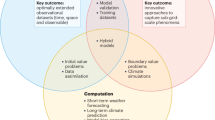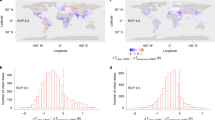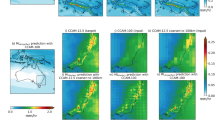Abstract
Many cities are interested in leveraging artificial intelligence and machine learning (ML) to help urban climate change mitigation (UCCM). Researchers and practitioners, however, are only beginning to understand how ML can contribute to achieving climate targets in cities. Here, we systematically map 2,300 peer-reviewed articles published between 1994 and 2024 that explore the use of ML in UCCM. We find that, despite fast growth in this research area, the use of generative artificial intelligence and large language models remains negligible, which contrasts to their increasing adoption in other urban domains. Among 40 identified application areas, ML research focuses predominantly on high-impact mitigation options denoted by the Intergovernmental Panel on Climate Change. This trend may partly be driven by data availability and commercial interest, which risk perpetuating geographic inequities and diverting efforts toward less impactful mitigation options. We therefore offer recommendations to guide the impactful deployment of ML solutions in UCCM.
This is a preview of subscription content, access via your institution
Access options
Subscribe to this journal
Receive 12 digital issues and online access to articles
$119.00 per year
only $9.92 per issue
Buy this article
- Purchase on SpringerLink
- Instant access to full article PDF
Prices may be subject to local taxes which are calculated during checkout


Similar content being viewed by others
Data availability
The data supporting the findings of this study are available within the article and its Supplementary Information. The steps for curating the data from the WoS and the ‘AI conferences info’ repository are provided in the text. The repository operates under a CC-BY-SA-4.0 license.
Code availability
Code developed for this study is available via Code Ocean at https://codeocean.com/capsule/6679595/tree.
References
Lwasa, S. et al. Urban systems and other settlements. In Climate Change 2022: Mitigation of Climate Change (eds Shukla, P. R. et al.) (Cambrige Univ. Press, 2022).
Shukla, P. et al (eds). Climate Change 2022: Mitigation of Climate Change (Cambridge Univ. Press, 2022).
Sethi, M., Lamb, W., Minx, J. & Creutzig, F. Climate change mitigation in cities: a systematic scoping of case studies. Environ. Res. Lett. 15, 093008 (2020).
Kaack, L. H. et al. Aligning artificial intelligence with climate change mitigation. Nat. Clim. Change 12, 518–527 (2022).
Rolnick, D. et al. Tackling climate change with machine learning. ACM Comput. Surveys 55, 1–96 (2022).
Milojevic-Dupont, N. & Creutzig, F. Machine learning for geographically differentiated climate change mitigation in urban areas. Sustain. Cities Soc. 64, 102526 (2021).
Kim, H. et al. A systematic review of the smart energy conservation system: from smart homes to sustainable smart cities. Renew. Sustain. Energy Rev. 140, 110755 (2021).
Lai, C. S. et al. A review of technical standards for smart cities. Clean Technol. 2, 290–310 (2020).
Pereira, G. V., Parycek, P., Falco, E. & Kleinhans, R. Smart governance in the context of smart cities: a literature review. Inform. Polity 23, 143–162 (2018).
Gracias, J. S., Parnell, G. S., Specking, E., Pohl, E. A. & Buchanan, R. Smart cities–a structured literature review. Smart Cities 6, 1719–1743 (2023).
Casali, Y., Aydin, N. Y. & Comes, T. Machine learning for spatial analyses in urban areas: a scoping review. Sustain. Cities Soc. 85, 104050 (2022).
Haddaway, N. R., Bernes, C., Jonsson, B.-G. & Hedlund, K. The benefits of systematic mapping to evidence-based environmental management. Ambio 45, 613–620 (2016).
Haddaway, N., Macura, B., Whaley, P. & Pullin, A. ROSES flow diagram for systematic reviews, version 1.0. Figshare https://doi.org/10.6084/m9.figshare.5897389.v3 (2018).
James, K. L., Randall, N. P. & Haddaway, N. R. A methodology for systematic mapping in environmental sciences. Environ. Evidence 5, 1–13 (2016).
Lamb, W. F., Callaghan, M. W., Creutzig, F., Khosla, R. & Minx, J. C. The literature landscape on 1.5 C climate change and cities. Curr. Opin. Environ. Sustain. 30, 26–34 (2018).
Sethi, M. & Creutzig, F. Leaders or laggards in climate action? Assessing GHG trends and mitigation targets of global megacities. PLOS Clim. 2, e0000113 (2023).
Li, X. et al. Short-term forecast of bicycle usage in bike sharing systems: a spatial-temporal memory network. IEEE Trans. Intell. Transp. Syst. 23, 10923–10934 (2021).
Yusuf, J., Hasan, A. J., Garrido, J., Ula, S. & Barth, M. J. A comparative techno-economic assessment of bidirectional heavy duty and light duty plug-in electric vehicles operation: a case study. Sustain. Cities Soc. 95, 104582 (2023).
Aziz, H. A., Zhu, F. & Ukkusuri, S. V. Learning-based traffic signal control algorithms with neighborhood information sharing: an application for sustainable mobility. J. Intell. Transp. Syst. 22, 40–52 (2018).
Seyrfar, A., Ataei, H., Movahedi, A. & Derrible, S. Data-driven approach for evaluating the energy efficiency in multifamily residential buildings. Pract. Periodical Struct. Des. Constr. 26, 04020074 (2021).
Zhang, J. et al. The Traj2Vec model to quantify residents’ spatial trajectories and estimate the proportions of urban land-use types. Int. J. Geogr. Inform. Sci. 35, 193–211 (2021).
Nutkiewicz, A., Mastrucci, A., Rao, N. D. & Jain, R. K. Cool roofs can mitigate cooling energy demand for informal settlement dwellers. Renew. Sustain. Energy Rev. 159, 112183 (2022).
Linton, S., Clarke, A. & Tozer, L. Technical pathways to deep decarbonization in cities: eight best practice case studies of transformational climate mitigation. Energy Res. Soc. Sci. 86, 102422 (2022).
Verbeek, A. & Lundqvist, M. Artificial Intelligence, Blockchain and the Future of Europe: How Disruptive Technologies Create Opportunities for a Green and Digital Economy, Technical Report (European Investment Bank, 2021).
Maslej, N. et al. The AI Index 2023 Annual Report, Technical Report (Institute for Human-Centered AI, Stanford University, 2023).
Kitsara, I. Artificial Intelligence and the Digital Divide: From an Innovation Perspective. In Platforms and Artificial Intelligence: The Next Generation of Competences (ed. Bounfour, A.) 245–265 (Springer, 2022).
Hao, X., Zhou, Y., Wang, H. & Ouyang, M. Plug-in electric vehicles in China and the USA: a technology and market comparison. Mitig. Adapt. Strateg. Glob. Change 25, 329–353 (2020).
Ugarteche, O., de León, C. & García, J. China and the energy matrix in Latin America: governance and geopolitical perspective. Energy Policy 177, 113435 (2023).
A Renovation Wave for Europe—Greening our Buildings, Creating Jobs, Improving Lives, Technical Report (European Commission, 2020).
Bakó, F., Berkes, J. & Szigeti, C. Households’ electricity consumption in Hungarian urban areas. Energies 14, 2899 (2021).
Stensjö, I. P., Ferreira, C. C. & Loura, R. M. Classification and grouping of Brazilian cities in heating and cooling degrees-day: 1960 to 2013. Urbe Rev. Brasil. de Gestão Urbana 9, 286–300 (2017).
Praene, J. P., Malet-Damour, B., Radanielina, M. H., Fontaine, L. & Riviere, G. GIS-based approach to identify climatic zoning: a hierarchical clustering on principal component analysis. Build. Environ. 164, 106330 (2019).
Wu, T.-G. et al. Identifying low-PM2.5 exposure commuting routes for cyclists through modeling with the random forest algorithm based on low-cost sensor measurements in three Asian cities. Environ. Pollut. 294, 118597 (2022).
Palme, M., Inostroza, L. & Salvati, A. Technomass and cooling demand in South America: a superlinear relationship? Build. Res. Inform. 46, 864–880 (2018).
Petropoulos, G. P., Kalivas, D. P., Georgopoulou, I. A. & Srivastava, P. K. Urban vegetation cover extraction from hyperspectral imagery and geographic information system spatial analysis techniques: case of Athens, Greece. J. Appl. Remote Sens. 9, 096088 (2015).
Li, X. et al. Developing urban residential reference buildings using clustering analysis of satellite images. Energy Build. 169, 417–429 (2018).
Yigit, S. A machine-learning-based method for thermal design optimization of residential buildings in highly urbanized areas of Turkey. J. Build. Eng. 38, 102225 (2021).
Adeogba, E., Barty, P., O’Dwyer, E. & Guo, M. Waste-to-resource transformation: gradient boosting modeling for organic fraction municipal solid waste projection. ACS Sustain. Chem. Eng. 7, 10460–10466 (2019).
Jiang, F., Ma, J. & Li, Z. Pedestrian volume prediction with high spatiotemporal granularity in urban areas by the enhanced learning model. Sustain. Cities Soc. 79, 103653 (2022).
Manchella, K., Umrawal, A. K. & Aggarwal, V. Flexpool: a distributed model-free deep reinforcement learning algorithm for joint passengers and goods transportation. IEEE Trans. Intell. Transp. Syst. 22, 2035–2047 (2021).
Lork, C. et al. An uncertainty-aware deep reinforcement learning framework for residential air conditioning energy management. Appl. Energy 276, 115426 (2020).
Tien, P. W., Wei, S., Darkwa, J., Wood, C. & Calautit, J. K. Machine learning and deep learning methods for enhancing building energy efficiency and indoor environmental quality—a review. Energy AI 10, 100198 (2022).
Campbell-Arvai, V. & Lindquist, M. From the ground up: using structured community engagement to identify objectives for urban green infrastructure planning. Urban For. Urban Green. 59, 127013 (2021).
Ntakolia, C., Anagnostis, A., Moustakidis, S. & Karcanias, N. Machine learning applied on the district heating and cooling sector: a review. Energy Syst. 13, 1–30 (2022).
Rong, K. & Luo, Y. Toward born sharing: the sharing economy evolution enabled by the digital ecosystems. Technol. Forecast. Soc. Change 196, 122776 (2023).
Adler, P. & Florida, R. The rise of urban tech: how innovations for cities come from cities. Reg. Stud. 55, 1787–1800 (2021).
Albuquerque, V., Sales Dias, M. & Bacao, F. Machine learning approaches to bike-sharing systems: a systematic literature review. ISPRS Int. J. Geo-Inform. 10, 62 (2021).
Shaygan, M., Meese, C., Li, W., Zhao, X. G. & Nejad, M. Traffic prediction using artificial intelligence: review of recent advances and emerging opportunities. Transp. Res. C 145, 103921 (2022).
Font Vivanco, D. et al. Rebound effect and sustainability science: a review. J. Ind. Ecol. 26, 1543–1563 (2022).
Sovacool, B. K., Newell, P., Carley, S. & Fanzo, J. Equity, technological innovation and sustainable behaviour in a low-carbon future. Nat. Hum. Behav. 6, 326–337 (2022).
McMillan, L. & Varga, L. A review of the use of artificial intelligence methods in infrastructure systems. Eng. Appl. Artif. Intell. 116, 105472 (2022).
Taiwo, R., Ben Seghier, M. E. A. & Zayed, T. Toward sustainable water infrastructure: the state-of-the-art for modeling the failure probability of water pipes. Water Resour. Res. 59, e2022WR033256 (2023).
Burley Farr, K., Song, K., Yeo, Z. Y., Johnson, E. & Hsu, A. Cities and regions tackle climate change mitigation but often focus on less effective solutions. Commun. Earth Environ. 4, 439 (2023).
Chen, S. & Jia, K. How local governments prioritize multiple conflicting goals: beyond the sole-goal perspective. Public Admin. 101, 522–538 (2023).
Meena, M. et al. Municipal solid waste: Opportunities, challenges and management policies in India: a review. Waste Manag. Bull. 1, 4–18 (2023).
Moroni, S. & Chiffi, D. Uncertainty and planning: cities, technologies and public decision-making. Perspect. Sci. 30, 237–259 (2022).
Bright, J. et al. Generative AI is already widespread in the public sector: evidence from a survey of UK public sector professionals. Digit. Gov.: Res. Pract. 6, 1–13 (2025).
Zhu, D. & Liu, H. City AI: a strategic framework for urban artificial intelligence application and development. Urban Informatics 4, 1–14 (2025).
Li, Z. et al. Urban computing in the era of large language models. Preprint at https://doi.org/10.48550/arXiv.2504.02009 (2025).
Luccioni, S., Jernite, Y. & Strubell, E. Power hungry processing: watts driving the cost of AI deployment? In Proc. 2024 ACM Conference on Fairness, Accountability, and Transparency 85–99 (Association for Computing Machinery, 2024).
Dodge, J. et al. Measuring the carbon intensity of AI in cloud instances. In Proc. 2022 ACM Conference on Fairness, Accountability, and Transparency 1877–1894 (Association for Computing Machinery, 2022).
Zhao, F., Fashola, O. I., Olarewaju, T. I. & Onwumere, I. Smart city research: a holistic and state-of-the-art literature review. Cities 119, 103406 (2021).
João, B., Nascimento, D., Souza, C. L. D. & Serralvo, F. A. A systematic review of smart cities and the internet of things as a research topic. Cadernos EBAPE.BR. 17, 1115–1130 (2020).
Pasgaard, M. & Strange, N. A quantitative analysis of the causes of the global climate change research distribution. Glob. Environ. Change 23, 1684–1693 (2013).
Tennant, J. P. Web of Science and Scopus are not global databases of knowledge. Eur. Sci. Edit. 46, e51987 (2020).
Asubiaro, T., Onaolapo, S. & Mills, D. Regional disparities in Web of Science and Scopus journal coverage. Scientometrics 129, 1469–1491 (2024).
Boeing, G., Pilgram, C. & Lu, Y. Urban street network design and transport-related greenhouse gas emissions around the world. Transp. Res. D 127, 103961 (2024).
Xiao, C. S. et al. Design effects of cycle infrastructure changes: an exploratory analysis of cycle levels. Transp. Res. Interdisc. Perspect. 22, 100949 (2023).
Oyedemi, T. D. Digital coloniality and ‘next billion users’: the political economy of Google Station in Nigeria. Inform. Commun. Soc. 24, 329–343 (2021).
Birhane, A. et al. The values encoded in machine learning research. In Proc. 2022 ACM Conference on Fairness, Accountability, and Transparency 173–184 (Association for Computing Machinery, 2022).
Birhane, A. Algorithmic colonization of Africa. SCRIPTed 17, 389 (2020).
Sietsma, A. J., Ford, J. D. & Minx, J. C. The next generation of machine learning for tracking adaptation texts. Nat. Clim. Change 14, 31–39 (2024).
Vinuesa, R. et al. The role of artificial intelligence in achieving the Sustainable Development Goals. Nat. Commun. 11, 233 (2020).
Sculley, D. et al. Hidden technical debt in machine learning systems. In Advances in Neural Information Processing Systems 28 (eds Cortes C., Lawrence N., Lee D., Sugiyama M. & Garnett R.) (Curran Associates, Inc., 2015).
Bulkeley, H. Cities and the governing of climate change. Ann. Rev. Environ. Resour. 35, 229–253 (2010).
Jiang, W. Bike sharing usage prediction with deep learning: a survey. Neur. Comput. Appl. 34, 15369–15385 (2022).
Repke, T. & Callaghan, M. NACSOS-nexus: NLP assisted classification, synthesis and online screening with new and extended usage scenarios. Preprint at https://doi.org/10.48550/arXiv.2405.04621 (2024).
Webersinke, N., Kraus, M., Bingler, J. & Leippold, M. ClimateBERT: a pretrained language model for climate-related text. In Proc. AAAI 2022 Fall Symposium: The Role of AI in Responding to Climate Challenges (2022); https://doi.org/10.48550/arXiv.2212.13631
Callaghan, M. & Müller-Hansen, F. Statistical stopping criteria for automated screening in systematic reviews. Syst. Rev. 9, 1–14 (2020).
Ivanova, D. et al. Quantifying the potential for climate change mitigation of consumption options. Environ. Res. Lett. 15, 093001 (2020).
Standard country or area codes for statistical use. United Nations Statistics Division https://unstats.un.org/unsd/methodology/m49/ (2025).
Hamel, R. E. The dominance of English in the international scientific periodical literature and the future of language use in science. Aila Rev. 20, 53–71 (2007).
Petersen, K. & Gerken, J. M. On the road to interactive LLM-based systematic mapping studies. Inform. Softw. Technol. 178, 107611 (2025).
Losi, E., Manservigi, L., Spina, P. R. & Venturini, M. Data-driven approach for the detection of faults in district heating networks. Sustain. Energy Grids Netw. 38, 101355 (2024).
Acknowledgements
This research was supported through a scholarship for M.J.H. by the Heinrich Böll Foundation. We thank F. Pachter for supporting with the coding of the articles and M. Callaghan for advising on prioritized abstract screening.
Author information
Authors and Affiliations
Contributions
N.M.-D. and L.H.K. conceived of the study, and N.M.-D., L.H.K. and M.J.H. designed the search queries. T.R. managed the process for prioritized abstract screening and was responsible for the fine-tuning of the classifier. M.J.H., N.M.-D. and L.H.K. performed the manual coding. M.J.H. led the analysis of relevant papers. All authors analyzed the results and interpreted the findings. M.J.H. created the figures and developed the initial draft. M.J.H. and L.H.K. wrote the draft with the help of N.M.-D. L.H.K. and F.C. supervised the research. All authors participated in the editing of the paper.
Corresponding author
Ethics declarations
Competing interests
L.H.K., N.M.-D. and F.C. are affiliated with Climate Change AI. M.J.H. is affiliated with Urban AI.
Peer review
Peer review information
Nature Cities thanks Anne Sietsma and the other, anonymous, reviewer(s) for their contribution to the peer review of this work.
Additional information
Publisher’s note Springer Nature remains neutral with regard to jurisdictional claims in published maps and institutional affiliations.
Extended data
Supplementary information
Supplementary Information
Supplementary Information 1–3.
Supplementary Data 1
Dataframe with all the relevant papers included in our sample, consisting of three tabs (the first tab includes all relevant papers from the first round of coding, the second tab those from the extended timeframe and search queries, and the third tab all relevant papers from conference proceedings).
Rights and permissions
Springer Nature or its licensor (e.g. a society or other partner) holds exclusive rights to this article under a publishing agreement with the author(s) or other rightsholder(s); author self-archiving of the accepted manuscript version of this article is solely governed by the terms of such publishing agreement and applicable law.
About this article
Cite this article
Hintz, M.J., Milojevic-Dupont, N., Creutzig, F. et al. A systematic map of machine learning for urban climate change mitigation. Nat Cities (2025). https://doi.org/10.1038/s44284-025-00328-5
Received:
Accepted:
Published:
DOI: https://doi.org/10.1038/s44284-025-00328-5



